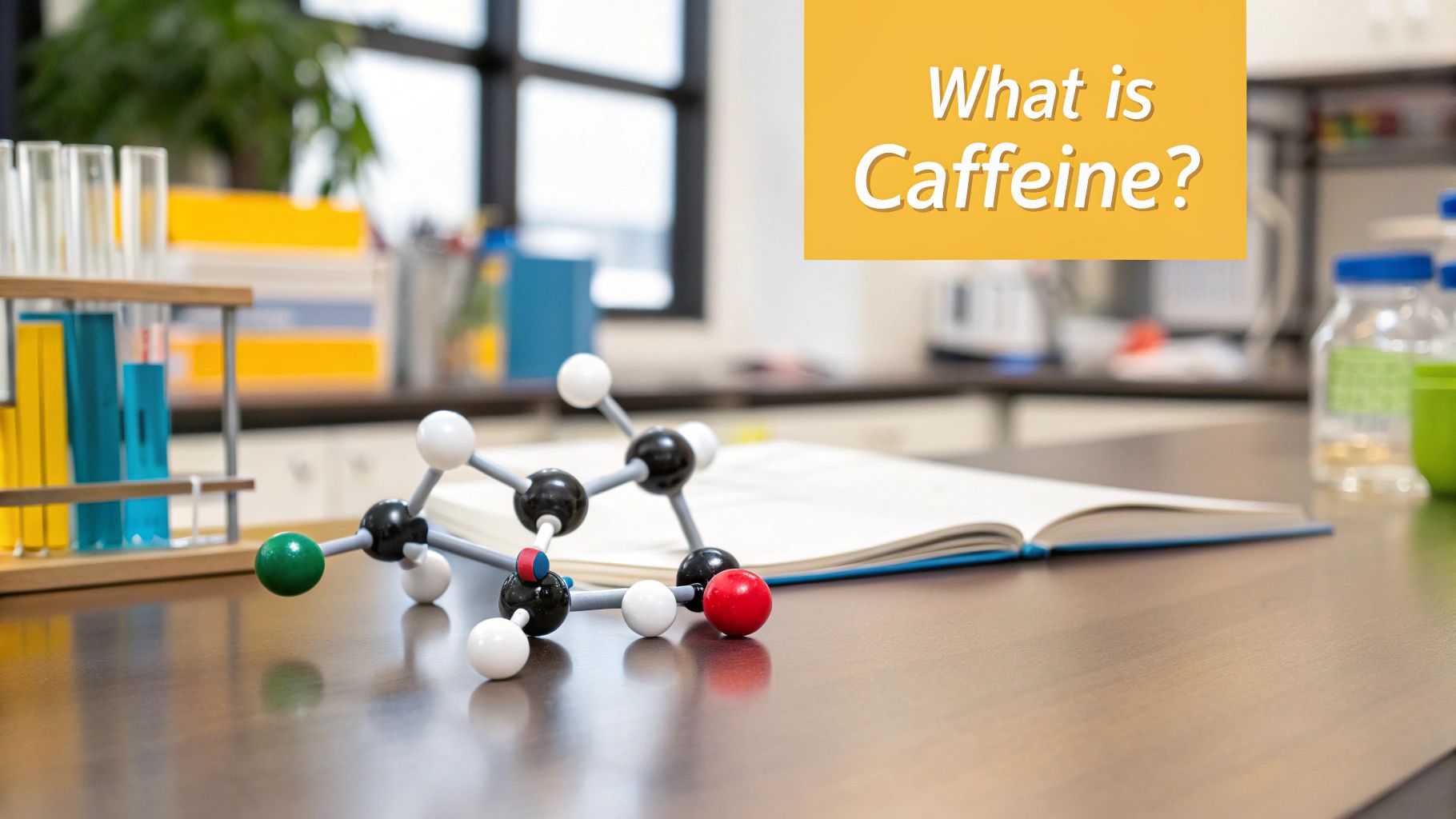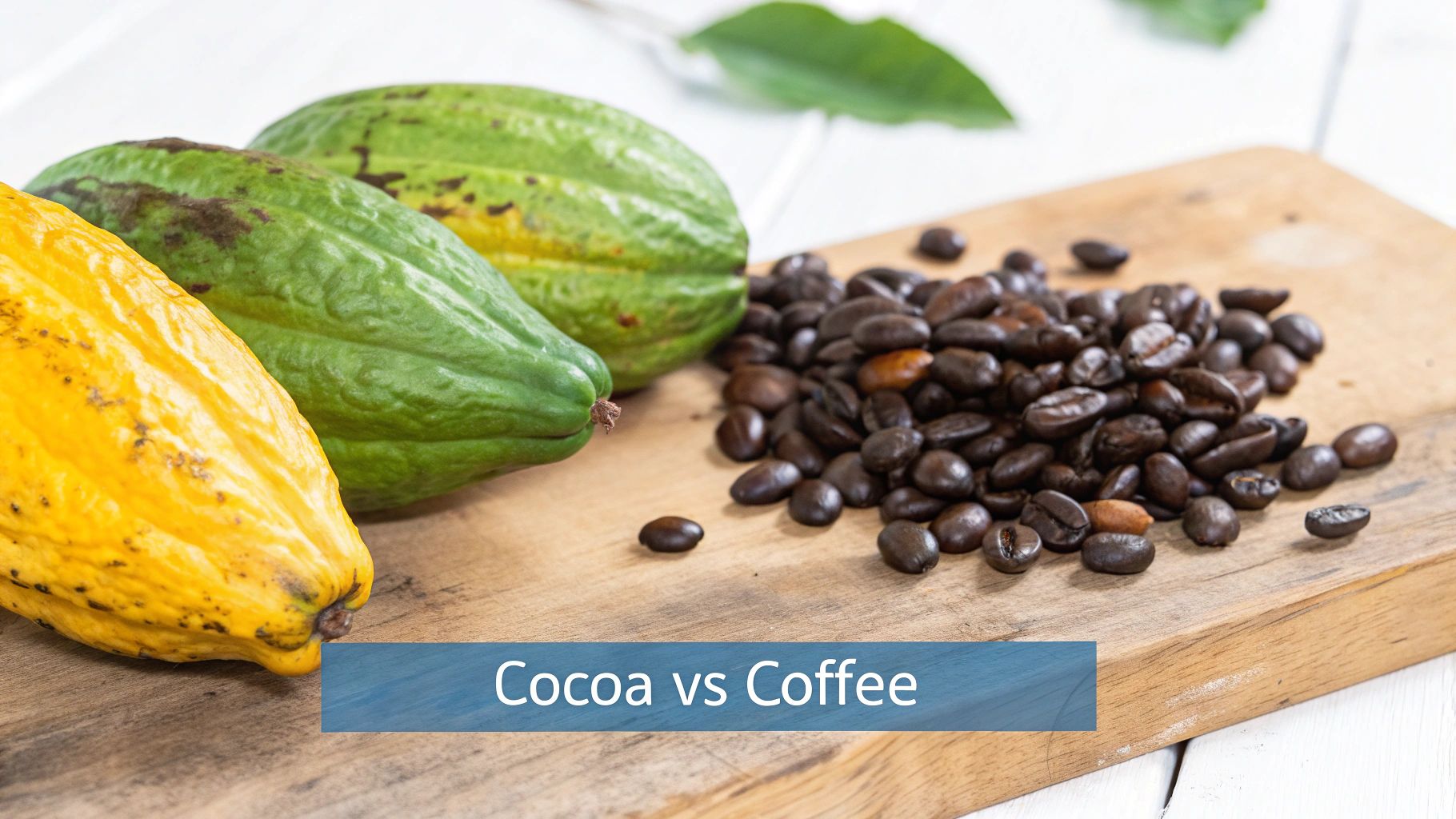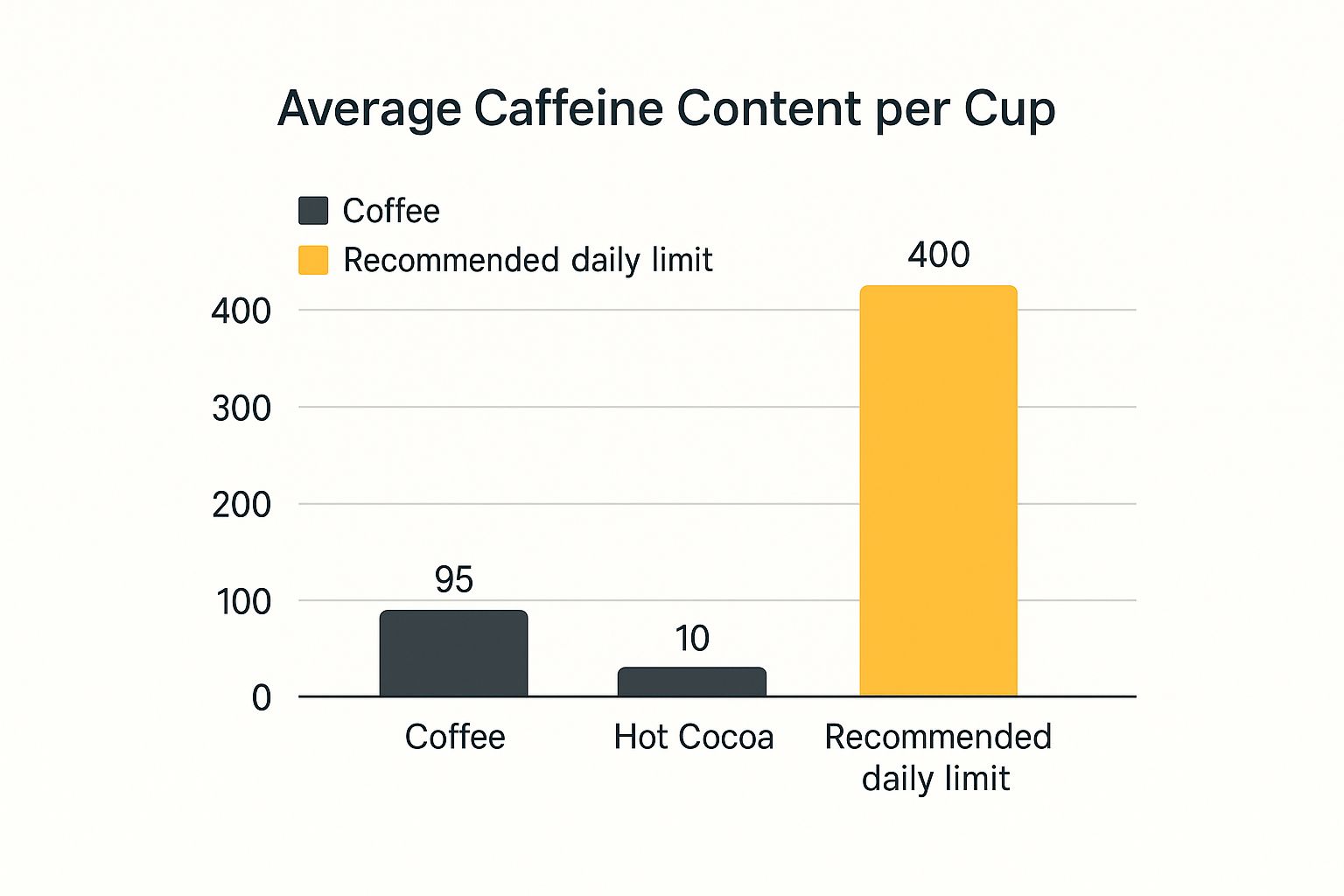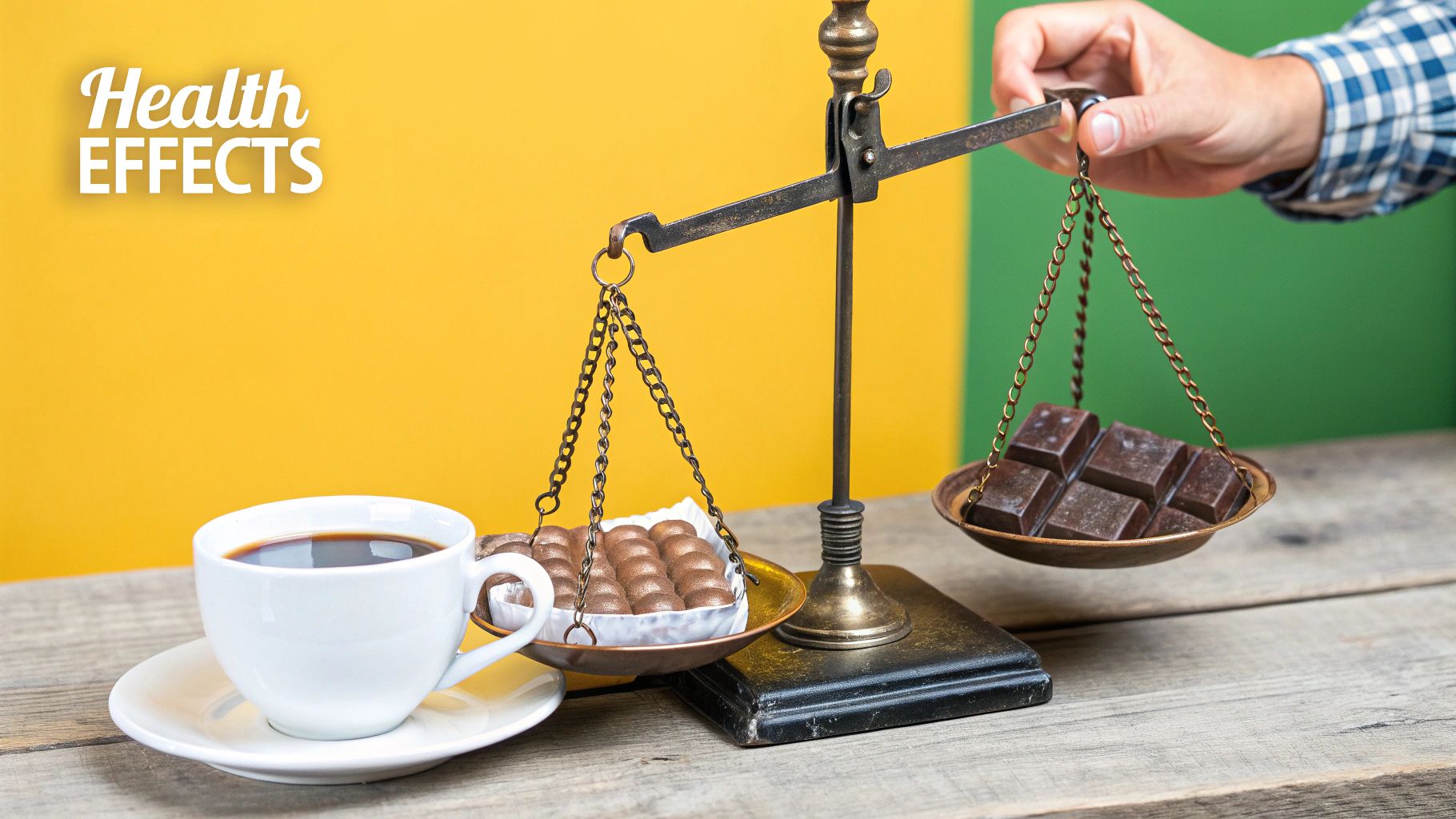When you stack up caffeine in cocoa vs coffee, the difference is night and day. Simply put, coffee packs a much bigger caffeine punch per serving. A typical cup of coffee delivers a serious jolt, whereas cocoa gives you a much gentler lift. This makes them perfect for completely different situations and times of day.
Caffeine In Coffee vs Cocoa A Quick Comparison
Though they both come from beans and have stimulant effects, coffee and cocoa are in different leagues when it comes to caffeine. This all comes down to their natural chemistry and how we process them. Coffee beans are loaded with caffeine from the start, and the roasting process is designed to preserve that key component.
On the other hand, cacao beans—the origin of all things cocoa and chocolate—start with far less caffeine. Their main stimulant is actually theobromine, a milder cousin to caffeine. The journey from cacao bean to cocoa powder involves steps like fermentation, roasting, and sometimes alkalization (the "Dutching" process), which can reduce the caffeine levels even further.
What this means for you is that even a rich, dark cup of hot cocoa won’t ever come close to the caffeine in your standard morning coffee. Grasping this core difference is the first step in picking the right drink for the moment, whether you need a powerful wake-up call or just a subtle afternoon pick-me-up.
Key Stimulant Differences At A Glance
To really see the gap between caffeine in cocoa vs coffee, let's look at the numbers for a typical serving. Coffee's caffeine is a heavyweight contender, while cocoa's is a featherweight. This positions coffee as the go-to for a sharp boost in alertness and cocoa as a much lower-impact choice.
These roasted coffee beans are the source of that high-octane brew we're talking about.

The deep, oily sheen on these beans hints at the potent drink they'll produce, a direct result of their natural makeup and the roasting that unlocks their flavor and energy.
The most important thing to remember is this: Coffee's energy is driven by caffeine, giving you a sharp, focused spike. Cocoa's energy is driven by theobromine, offering a gentler, longer-lasting lift that feels different in both body and mind.
To make it even clearer, here’s a quick breakdown of what you can expect from a standard cup of each.
At-a-Glance Caffeine Content Coffee vs Cocoa
| Beverage (8 oz / 240 ml serving) | Typical Caffeine Range (mg) | Primary Stimulant |
|---|---|---|
| Brewed Coffee | 95 - 200 mg | Caffeine |
| Hot Cocoa (from mix) | 5 - 10 mg | Theobromine |
| Natural Unsweetened Cocoa (1 tbsp) | ~12 mg | Theobromine |
As you can see, a regular cup of coffee can easily have 10 to 20 times more caffeine than a cup of hot cocoa. This initial look sets the stage for a deeper dive into exactly why these two beloved beverages are so different, from the farm all the way to your mug.
Diving Into the Botanical Roots of Caffeine

Before we can even talk about roasting or brewing, the big difference in caffeine in cocoa vs coffee starts with the plants themselves. Both the Coffea plant (coffee) and the Theobroma cacao tree (cocoa) produce stimulating compounds called alkaloids. Think of these as the plant's built-in defense system, designed to keep pests away.
The key difference is which alkaloid each plant favors. The coffee plant goes all-in on caffeine as its primary weapon, leading to a bean naturally loaded with the powerful stimulant. The cacao tree, on the other hand, leans more on theobromine—a much gentler cousin to caffeine—with caffeine playing a supporting role. This is the fundamental reason one gives you a jolt and the other a gentle lift.
The Coffee Bean: Nature's Caffeine Powerhouse
Coffee beans are the seeds tucked inside the fruit of the Coffea plant, and they come pre-loaded with a significant amount of caffeine. Just how much depends on the specific species, which creates a clear ranking of potency right from the start.
Two species rule the global coffee scene:
- Arabica (Coffea arabica): Prized for its complex, aromatic flavors, Arabica beans have a caffeine content of about 1.2% to 1.5% by weight.
- Robusta (Coffea canephora): Living up to its name, Robusta has a bolder, stronger flavor and packs a serious punch with 2.2% to 2.7% caffeine—nearly double that of Arabica.
So, a single Robusta bean has about twice the caffeine as an Arabica bean of the same size. These foundational differences are critical to understand, and you can learn more about cocoa beans vs coffee beans in our detailed guide.
The botanical reality is simple: coffee plants evolved to produce high levels of caffeine. This isn't an accident of processing; it's a core feature of the plant's biology, ensuring a stimulating beverage from the outset.
The Cacao Bean: A Much Milder Profile
Cacao beans, which grow inside the large pods of the Theobroma cacao tree, tell a different story. Their stimulant effect comes mostly from theobromine, which delivers a smoother, less intense energy boost. The amount of actual caffeine in raw cacao beans is way lower than in coffee, typically ranging from just 0.1% to 0.5%.
Just like coffee, different cacao varieties have slightly different caffeine levels:
- Criollo: A rare, premium bean known for its delicate flavor, it tends to be on the lower end of the caffeine spectrum.
- Forastero: This hardy variety makes up the bulk of the world's cocoa and has a moderate amount of caffeine.
- Trinitario: A hybrid of the other two, its caffeine content lands somewhere in the middle.
Interestingly, where the cacao is grown matters a lot. One major study found that cocoa from South America and the Caribbean had much more caffeine than cocoa from Africa. Some samples from Ecuador and Peru packed over twice the caffeine of those from West Africa, with the highest-caffeine samples having over five times more than the lowest.
This natural starting point really sets the stage. No matter how you process it, you can't make cocoa as caffeine-heavy as coffee because the botanical blueprint just isn't there to begin with.
How Processing Shapes Your Buzz
The path from bean to cup is where coffee and cocoa really start to go their separate ways. Think of it like this: coffee processing is all about preserving and highlighting its caffeine, while cocoa processing is focused on crafting that rich, complex chocolate flavor, often at the expense of its stimulant content.
You can't just look at a raw bean and know what you're getting. The choices made during roasting, fermentation, and other steps are what truly determine the final kick. This is the real story behind the caffeine in cocoa vs coffee.
Coffee Processing: Built for a Caffeine Kick
With coffee, almost every step in the process is fine-tuned to deliver a potent and predictable dose of caffeine. Roasting is the most transformative part, turning those raw, green beans into the fragrant brown ones we all know and love.
There's a common myth that darker roasts pack more punch. It's actually the other way around. Caffeine is pretty tough, but the intense, prolonged heat of a dark roast can burn a little bit of it off.
- Light Roast: These beans are roasted for less time, so they stay denser and hold onto nearly all their original caffeine. If you measure your coffee by the scoop, a light roast will often give you a bigger jolt.
- Dark Roast: Roasted longer, these beans puff up and lose some mass, making them less dense. Scoop for scoop, a dark roast has a bit less caffeine, though the difference is small if you're measuring by weight.
The grind matters, too. A fine grind, like what you’d use for espresso, exposes more of the bean's surface area. This lets hot water pull out the caffeine more effectively, which is how you get such a concentrated shot from a small amount of coffee.
Cocoa Processing: All About the Flavor
Turning cacao into cocoa powder is a delicate art. The goal is to develop flavor, and each step tends to whittle away at the bean's natural caffeine and theobromine.
It starts with fermentation and drying. This crucial stage is where the precursors to that classic chocolatey taste are born, but it’s also where some of the stimulant compounds begin to break down.
The biggest game-changer for cocoa's stimulant levels is a process called "Dutching." Here, the beans are washed in an alkaline solution to mellow out their natural acidity. This gives you a darker powder with a smoother taste, but it can also slash the caffeine content significantly.
This Dutch-processed cocoa is what you'll find in most hot chocolate mixes, which explains why they barely have any caffeine. Natural cocoa powder, on the other hand, skips this step, so it holds onto more of its stimulants and beneficial flavonoids—though it still contains far less than coffee.
Side-by-Side: How Processing Creates a Different Drink
Let's break down how these different paths lead to such different results in your mug.
| Processing Step | Impact on Coffee | Impact on Cocoa |
|---|---|---|
| Roasting | Preserves most caffeine. Lighter roasts are denser, often yielding a bit more caffeine by volume. | Develops deep chocolate flavors but reduces some caffeine and theobromine along the way. |
| Grinding | A finer grind means more surface area, which helps extract caffeine more efficiently. | The grind itself doesn't change the caffeine content, but it prepares the cocoa for use. |
| Alkalization (Dutching) | Not used in coffee processing. | Significantly reduces caffeine and theobromine, creating a milder, less bitter product. |
| Decaffeination | A specific process that removes up to 97% of caffeine while trying to keep the flavor intact. | Not really a thing for cocoa, since its caffeine levels are already naturally low. |
When all is said and done, the journey from field to cup solidifies the core difference between these two beverages. Coffee production is engineered to deliver that reliable caffeine hit we count on, with roast and grind acting as the fine-tuning dials. Cocoa processing, however, is more about subtraction—gently removing bitterness and stimulants to perfect a smooth, delicious flavor.
Comparing Caffeine Content by Beverage Type
To get a real sense of the caffeine difference between cocoa and coffee, we have to look past the beans and focus on what’s actually in our mugs. How we prepare our drinks, the serving size, and even the brand we choose can make a huge difference in the final caffeine count. This is where the caffeine in cocoa vs coffee debate gets practical.
A standard drip coffee is worlds apart from a potent shot of espresso. In the same way, a hot cocoa made from a store-bought mix is nothing like a rich drink made with pure, unsweetened cocoa powder. Each one gives you a totally different experience, and understanding these differences is the key to managing your daily intake.
The chart below gives a great visual of just how stark the contrast is between a typical cup of coffee and a cup of hot cocoa, especially when you see it next to the recommended daily caffeine limit.

As you can see, a single coffee can take up a big chunk of your daily caffeine budget, while hot cocoa barely makes a dent.
Coffee Preparations: A Spectrum of Strength
With coffee, the brewing method is king when it comes to caffeine. Different extraction techniques pull caffeine out at different rates, leading to a surprisingly wide range of potency from one cup to the next.
-
Drip Brewed Coffee: This is the go-to for most of us. A typical 8-ounce cup lands somewhere between 95 and 165 mg of caffeine. It’s a solid, balanced dose that's perfect for kick-starting your morning.
-
Espresso: Brewed hot and fast under pressure, a single 1-ounce shot of espresso packs about 63 mg of caffeine. While that’s less than a full cup of drip, it's way more concentrated ounce for ounce.
-
Cold Brew: Made by steeping grounds in cold water for 12 to 24 hours, this method creates a smooth, low-acid concentrate. An 8-ounce serving can be surprisingly strong, often clocking in at 150 to 200 mg of caffeine, though this depends heavily on how much you dilute it.
-
Instant Coffee: Quick and easy, instant coffee is generally a bit lighter on the caffeine. An 8-ounce cup usually has between 60 and 80 mg.
Getting familiar with the different types of coffees and how they're brewed is essential for anyone looking to fine-tune their caffeine habit.
The bottom line for coffee? How you brew it changes everything. A 12-ounce mug of strong cold brew might have nearly three times the caffeine as a single espresso shot, showing just how much variety exists.
Cocoa and Chocolate: The Milder Side
If you're looking for a gentler lift, cocoa and chocolate are your best friends. The caffeine here is consistently low, making them ideal for those cozy moments when you want comfort, not a massive jolt.
Here’s a quick breakdown:
| Beverage / Food Item | Serving Size | Typical Caffeine Range (mg) |
|---|---|---|
| Hot Cocoa (from mix) | 8 oz (240 ml) | 5 - 10 mg |
| Natural Cocoa Powder | 1 tbsp | ~12 mg |
| Dark Chocolate (70-85%) | 1 oz (28 g) | 20 - 25 mg |
| Milk Chocolate | 1 oz (28 g) | 5 - 10 mg |
A cup of hot cocoa made from a standard mix barely moves the needle on caffeine. Even if you use a tablespoon of natural, unsweetened cocoa powder—which has more kick than the Dutch-processed kind—you’re still looking at a very modest dose.
Diving into food science research really drives the point home. Studies show that dark chocolate has about 114 mg of caffeine per 100 grams, but cocoa-based drinks have far less, around 3 mg per 100 grams. Compare that to some instant coffee powders, which can contain a staggering 3,000 mg of caffeine per 100 grams. The data doesn't lie: while solid chocolate has a noticeable amount of caffeine, cocoa drinks are firmly in the low-stimulant camp.
Understanding Theobromine: Cocoa's Milder Stimulant
When we talk about caffeine in cocoa vs coffee, it's easy to get tunnel-vision and just compare the caffeine numbers. But that misses the main character in cocoa’s story: theobromine. While coffee gets its signature kick almost entirely from caffeine, cocoa delivers a much gentler kind of energy, thanks to this unique, related compound. Theobromine is the primary alkaloid in cacao beans, and though it’s structurally similar to caffeine, its effect on the body is a world apart.
https://www.youtube.com/embed/IRQi2G7VQl8
Instead of the sharp, central nervous system jolt you get from coffee, theobromine provides a smoother, more sustained lift. It works differently, focusing more on the cardiovascular system and muscles. The result is a feeling of relaxed alertness, not the jittery tension that often comes with a strong cup of coffee.
The Gentle Lift Explained
The key difference really boils down to how each stimulant interacts with your body. Caffeine is a powerhouse central nervous system stimulant. It works by blocking adenosine receptors in your brain, which is what tricks you into feeling wide awake and alert, fast. It's a direct, potent mechanism that gives you that sharp energy peak.
Theobromine, on the other hand, is much kinder to your nervous system. It offers a more gradual and longer-lasting energy boost without the infamous caffeine peak-and-crash cycle. This is why cocoa can be a fantastic choice for a steady afternoon focus session, especially when another coffee might bring on the jitters or mess with your sleep later.
The feeling you get from a cocoa-based boost is often described as a gentle wave of energy and a noticeable mood lift—not a sudden jolt. Theobromine brings clarity without the edgy side effects, making it a great alternative for anyone sensitive to caffeine.
A Different Kind of Energy Boost
One of the most interesting effects of theobromine is its role as a vasodilator, which means it helps widen your blood vessels. This simple action improves blood flow throughout the body, which can actually help lower blood pressure and deliver more oxygen to your brain and muscles. This physiological effect is a big part of why high-quality cocoa can leave you feeling so good, both mentally and physically.
This is a stark contrast to caffeine, which is a vasoconstrictor and can narrow blood vessels.
So, let's break down how this actually feels in practice:
-
Coffee (Caffeine): You get a rapid, intense burst of mental alertness. It's the perfect tool for shaking off morning grogginess or powering through a tough task that needs immediate, sharp focus. The trade-off? It can sometimes lead to anxiety, jitters, and a harsh energy crash.
-
Cocoa (Theobromine): This one provides a slow-onset, sustained energy lift. It’s better suited for creative work, studying, or any activity where you need calm, steady focus over a few hours. It also tends to promote a sense of relaxation and can genuinely elevate your mood.
Choosing Your Stimulant for the Situation
Ultimately, the choice between coffee and cocoa isn't about which one is "better," but which one is better for the moment you're in.
If you need to wake up right now and tackle a high-pressure morning, coffee's caffeine is your best friend. Its direct, powerful impact is designed to overcome inertia and help you get things done.
But if you’re looking for a gentle mood lift, sustained focus for an afternoon project, or just a warm, comforting drink that won’t leave you feeling wired, cocoa is the clear winner. Its theobromine-driven energy supports a more balanced state of mind, turning the caffeine in cocoa vs coffee debate into a simple matter of picking the right tool for the job.
Choosing Your Beverage for Health and Lifestyle

So, coffee or cocoa? Making the right call really just comes down to knowing your own body, what you want to accomplish, and what your day looks like. The massive difference in caffeine in cocoa vs coffee means each drink is essentially a specialized tool. One is a powerhouse for alertness, and the other is a gentle nudge for your mood and focus.
Coffee is, without a doubt, the king of the morning kick-start. That jolt of energy is exactly why millions of us lean on it to get the day rolling. But that same strength can be a downside for some. If you're sensitive to caffeine, a strong cup can easily lead to jitters, anxiety, or a restless night, even if you drink it hours before bed.
Coffee: When to Drink It
I find myself reaching for a cup of coffee in a few key situations:
- Beating Morning Grogginess: When you need to go from zero to sixty, that 95-200 mg caffeine hit in a standard cup is hard to beat.
- Pre-Workout Boost: It's a proven way to enhance physical performance, making it the perfect partner for a session at the gym.
- Intense Focus Sessions: Got a big deadline or a complex problem to solve? Coffee provides that sharp mental edge you need for short bursts of high-stakes work.
Cocoa: A Gentler Alternative
On the other hand, cocoa is a fantastic alternative, especially if you're trying to cut back on stimulants without giving up a warm, comforting ritual. Its profile is completely different, with very low caffeine—usually just 5-10 mg per cup—but a healthy dose of theobromine and antioxidants. This unique mix gives you a mild, mood-lifting boost without any risk of overstimulation.
This makes cocoa the perfect evening wind-down drink. It’s comforting and indulgent but won't sabotage your sleep schedule. Instead of ramping you up, the theobromine gently improves blood flow, which contributes to a nice feeling of overall well-being.
When deciding, think about the desired outcome. Do you need a sharp spike in energy to perform a task, or a gentle, sustained lift to support your mood and focus over a longer period? Your answer will point you directly to the right mug.
Matching Your Drink to the Moment
To really nail your choice, pay attention to your daily rhythm and how you feel. If coffee leaves you feeling on edge or messes with your sleep, swapping it for cocoa in the afternoon can be a total game-changer. But if you truly need that reliable energy to power through a demanding morning, coffee is still your best bet.
The type of product matters, too. A quick cup of instant coffee, for example, gives you a moderate and pretty predictable dose of caffeine, which can be ideal for a busy day. If you're curious, you can read more about whether instant coffee is a healthy option on our blog.
Lab results really drive this point home. One study comparing different brands found that coffee could have caffeine levels as high as 427 μg/g. In stark contrast, the highest concentration found in cocoa products was a mere 19 μg/g. The researchers noted this makes cocoa a much safer choice for frequent consumption, helping to avoid risks like hypertension that can be linked to drinking too much coffee.
Ultimately, both coffee and cocoa can have a place in a well-rounded lifestyle. The trick is to listen to your body and match your drink to the moment. Do that, and you'll get the most out of every single cup.
Answering Your Questions
Even after breaking down the science, you probably have some real-world questions about choosing between cocoa and coffee. Let's tackle some of the most common ones.
Does Dark Chocolate Have a Lot of Caffeine?
It depends on how much you eat, but yes, it's a significant source. A big 100-gram (3.5-ounce) bar of very dark chocolate can pack 80-100 mg of caffeine—that’s as much as a cup of coffee.
But let's be realistic. Most of us eat a few squares, not the whole bar. A typical serving of about one ounce (30 grams) contains a much more manageable 25-40 mg of caffeine. So, while it's definitely a caffeine-rich food, a sensible portion won't send you bouncing off the walls like an espresso.
Which Is Better Before a Workout: Coffee or Cocoa?
If you’re looking for a serious jolt to power through a tough workout, coffee wins, hands down. Its high caffeine content hits you fast, sharpening your focus and boosting power for high-intensity training. It's a classic pre-workout for a reason.
Cocoa, on the other hand, is a different beast. Its theobromine helps with blood flow, which is great for endurance, but it just doesn't provide that central nervous system kick. Coffee delivers the immediate, potent energy most people want when they're about to lift heavy or push their limits.
For peak physical performance and mental drive, the caffeine punch from coffee is what you need. Think of cocoa as a gentle recovery aid that helps with circulation after you’re done.
Is It Okay to Drink Hot Cocoa Before Bed?
For almost everyone, it's perfectly fine. Your average mug of hot cocoa made from a standard mix has a tiny amount of caffeine, usually less than 10 mg. That's generally not enough to mess with your sleep.
The exception? If you're highly sensitive to caffeine, even that small dose might be noticeable. If you want a zero-risk option for a calming evening drink, an herbal tea is your best bet. But for most of us, a warm cup of hot cocoa is a comforting and safe way to wind down.
Ready for a consistently delicious coffee experience that fits your busy life? Cartograph Coffee offers premium, organic instant coffee that delivers exceptional flavor without the fuss. Perfect for your morning routine, your next camping trip, or a quick boost at the office. Discover the difference quality makes.